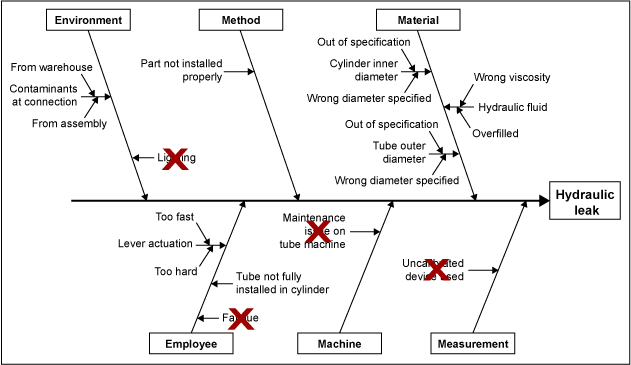General
Professional root cause analysis with Ishikawa diagram and it’s similarity with iceberg model

Introduction
The root cause analysis is a familiar process to all of us, regardless if you are a programmer, a doctor or an accountant. It is definitely an integral part of problem-solving and best practices in almost all companies, as it is necessary to understand the reasoning behind every incident that happened. To define the root cause analysis (RCA) we can say that it is the systematic approach in which we analyze when something goes wrong. The immediate response we have when something goes wrong is always to take action right away in order to prevent it from happening again. This might or might not be the best response because we are using hindsight here, so there is always some information which got lost along the way and therefore lead us up to this point. Information may indeed be lost along the way, but there must be a method to collect this information in order to get 100% accurate data when we are analyzing what’s gone wrong. That’s why Root Cause Analysis comes handy as a method to create order out of chaos and, identify the source of error.
Your process fails, the client Is not happy and, you are not sure what went wrong? Professional root cause analysis with Ishikawa diagram in partnership with your common sense can lead you to the solution. This is a very strong tool in managing business processes.
Before we go ahead, first, we should know about, what is Ishikawa diagram?
What is Ishikawa diagram?
Ishikawa diagram, it is also called as fishbone diagram. To lead a project successfully to its end, Ishikawa diagram is very crucial to know. For making a proper risk analysis and, to know problems properly, it is required. In root cause analysis project managers use this tool to define root causes of failure and, try to solve these problems. This fish bone structure gives the ultimate issue and factor that hinders project success. It is called as fish bone due to its appearance like a fish bony structure.
How to carry out professional root cause analysis with ishikawa diagram
The first step in root cause analysis is to collect data and information about a problem from different sources: current and former employees, customers, suppliers, managers, etc. The next step is to analyze this data and information with the help of Ishikawa Diagram.
Ishikawa diagrams are used in conjunction with brainstorming sessions to identify potential causes of problems that occur either during production or post-production (or both). A good way to use this diagram is by conducting interviews with team members who have expertise in each area.
The fish bone diagram consists of a main cause and several branches that are sub-causes. The main cause is called the “root cause” while the sub-causes are referred to as “branches”. Each branch can be further broken down into additional sub-branches, which may have their own causes and sub-causes. The purpose of this technique is to help identify all possible causes of an issue by examining it from multiple angles.
Once you’ve identified what could be causing your problem, you can start narrowing down your options based on their relative importance and likelihood (based on how many people suggested them). Then you can take action by eliminating those that don’t seem relevant or feasible. This should help lead you toward an effective solution for your project.
Types of causes to be noted while making root cause analysis
- Internal causes: These are factors within your organization that lead to an issue. It could be something like an employee mistake, lack of training or a simple misunderstanding that leads to a major concern.
- External causes: External factors outside your control often play a role in determining the likelihood and severity of problems. For example, weather conditions (such as rain) or government regulations (such as new tax laws) can have an impact on your business operations and productivity levels.
- Management system failures: Management systems are designed to prevent certain issues from occurring, but they can sometimes fail at this task due to poor design or inadequate implementation.
- Human errors: Human error refers to mistakes made by employees, contractors or temporary workers who work within your company on a regular basis. These mistakes could include operating machinery incorrectly or failing to follow safety procedures while working in dangerous environments.
Root cause analysis with ishikawa diagram and, it’s similarities with iceberg model
Iceberg model, as the name suggests that, this model is similar to iceberg. Only 10% can be seen while, 90% is underwater or hidden. There are always hidden factors present which, prove themselves influential in project management.
Iceberg model is another method of root cause analysis. Use of iceberg model can also help you to identify the cause of failure while managing your project. Based upon functionality, ishikawa diagram and, iceberg model are same things, but their method of cause analysis is little different from each other. Like ishikawa diagram, iceberg model also implies to the problems and, used to find root cause. Iceberg model also persist on the actual cause, as ishikawa diagram do.
Conclusion
Root cause analysis is the most important problem-solving tool. Almost all the projects, design and engineering process uses root cause analysis to detect causes of failure. People can do this using simple Ishikawa diagram. With this, project managers and process owners understand the reasons of their failures in the processes which are affecting business performance. We have discussed the connection between Root Cause Analysis and Ishikawa diagram above. Both of them are intended to expose a root cause in identifying the main reason for a defect or failure that happened. If you want to learn more about it, click the link above and get your desired information.
Click here for more interesting articles
Related posts:


Forex & Crypto
5 Best Ways to Earn Crypto While You Sleep in 2025
Categories
- Apps (1)
- Automotive (23)
- Beauty (7)
- Business (122)
- Celebrities (2)
- Digital Marketing (21)
- Ecommerce (2)
- Education (22)
- Entertainment (39)
- Events (6)
- Fashion (1)
- Features (4)
- Finance (1)
- Fitness (10)
- Food (2)
- Forex & Crypto (23)
- General (116)
- Health (48)
- House (61)
- Lifestyle (57)
- Marketing (8)
- Parenting (3)
- Pets (10)
- Real Estate (8)
- Safety and Security (14)
- Social Media (31)
- Sports (142)
- Technology (73)
- Travel (23)






















